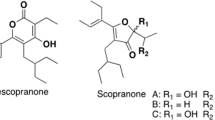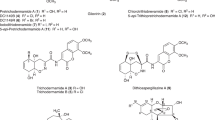Abstract
ISOTOPE tracer studies have established an important role for acetate and formate in the biosynthesis of stipitatic acid (6-hydroxytropolone-4-carboxylic acid) by Penicillium stipitatum and it is probable1 that the C7 tropolone ring is not formed by ring expansion from known C6 structures as proposed by Seshadri2. Seshadri also suggested 6-hydroxytropolone-3,4-dicar-boxylic acid as the immediate precursor of stipitatic acid. This possibility seemed likely since other Penicillium species yielded the compounds puberulic and puberulonic acids3 which are now known to be 6,7-dihydroxytropolone-4-carboxylic acid and the anhydride of 6,7-dihydroxytropolone-3,4-dicarboxylic acid, respectively4. Recently Segal5 isolated from P. stipitatum cultures an anhydride, stipitatonic acid, originally believed to be the 6-hydroxytropolone-3,4-dicarboxylic acid proposed by Seshadri, but now established as the 4,5 isomer6. Although puberulonic acid is usually written as indicated above, it seems reasonable to suppose that any adjacent pair of the four oxygen functions may form the tropolone function and it may equally be regarded as 3,4-dihydroxytro-polone-5,6-dicarboxylic acid, or analogous to stipitatonic acid, as 3,7-dihydroxytropolone-4,5-dicarboxylic acid.
This is a preview of subscription content, access via your institution
Access options
Subscribe to this journal
Receive 51 print issues and online access
$199.00 per year
only $3.90 per issue
Buy this article
- Purchase on Springer Link
- Instant access to full article PDF
Prices may be subject to local taxes which are calculated during checkout
Similar content being viewed by others
References
Bentley, R., Biochim. Biophys. Acta, 29, 666 (1958).
Seshadri, T. R., J. Sci. Indus. Res. (India), B. 14, 248 (1955).
Birkinshaw, J. H., and Raistrick, H., Biochem. J., 26, 441 (1932); Oxford, A. E., Raistrick, H., and Smith, G., Chem. and Ind., 41, 485 (1942).
For a recent review of the chemistry of the mould tropolones see Pauson, P. L., Chem. Rev., 55, 9 (1955); Nozoe, T., “Progress in the Chemistry of Organic Natural Products,” 13, 234 (1956).
Segal, W., Chem. and Ind., 1040 (1957).
Segal, W., Chem. and Ind., 1726 (1958); Doi, K., and Kitahara, Y., Bull. Chem. Soc. Japan, 31, 788 (1958).
Bentley, R., and Thiessen, C. P., Science, 122, 330 (1955); J. Biol. Chem., 226, 703 (1957).
Author information
Authors and Affiliations
Rights and permissions
About this article
Cite this article
BENTLEY, R., THIESSEN, C. Tropolone Biosynthesis: the Enzymatic Decarboxylation of Stipitatonic and Puberulonic Acids. Nature 184, 552–553 (1959). https://doi.org/10.1038/184552a0
Issue Date:
DOI: https://doi.org/10.1038/184552a0
Comments
By submitting a comment you agree to abide by our Terms and Community Guidelines. If you find something abusive or that does not comply with our terms or guidelines please flag it as inappropriate.



